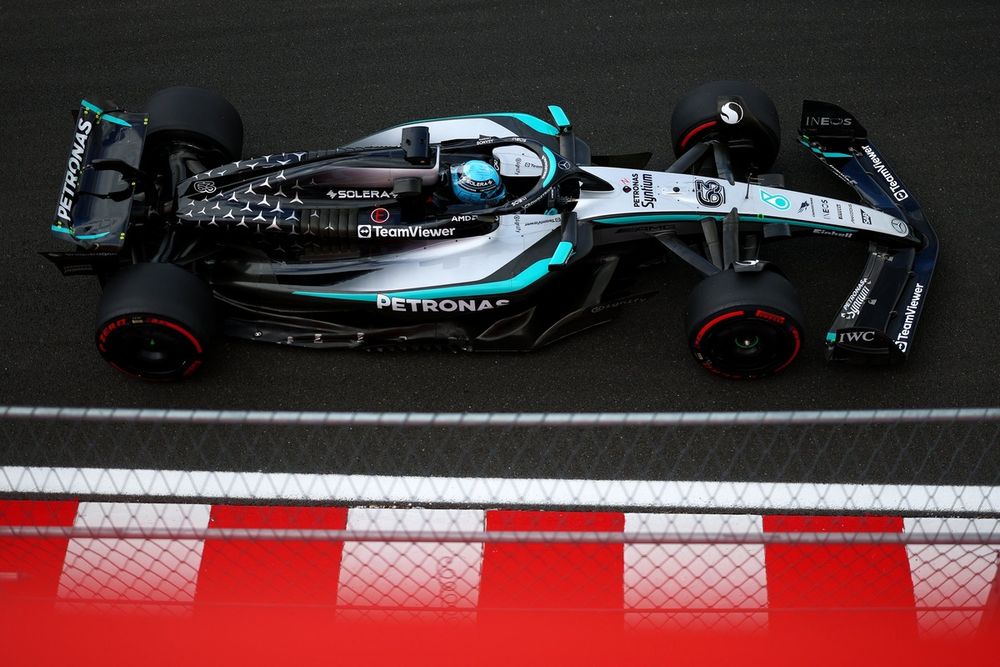“Nicely,” Mercedes F1 boss Toto Wolff instructed reporters after the Hungarian Grand Prix, “that rear axle can be ending up in a bin someplace, I suppose…”
The pattern line of Mercedes’ mid-season stoop in efficiency is extra apparent when you low cost the outlier results of the Canadian Grand Prix, the place George Russell gained and Kimi Antonelli turned the youngest-ever driver to face on a grand prix podium.
Russell claimed 4 podiums within the first six races, together with a exceptional second place in a failing automotive in Bahrain. However, Canada apart, qualifying and race efficiency has been problematic for the reason that crew launched a brand new rear-suspension configuration at Imola – then dropped it, solely to place it again on the automotive in Montreal.
It reverted to the earlier spec for Hungary after a poor weekend in Belgium, and each drivers reported better confidence even when it was solely Russell who got here away with any factors.
This decision-making inertia in recognising and addressing the issue is complicated to unpick. The proof factors not solely to Mercedes’ simulator instruments nonetheless failing to correlate with actual life, but additionally differing monitor configurations and climate situations including to the uncertainty.
Feeding into that uncertainty is the human aspect of engineers being reluctant to let go of a design philosophy they genuinely imagine to be helpful, regardless of growing proof on the contrary.
“Upgrades are right here to deliver efficiency, and there is a whole lot of simulations and evaluation that goes into placing components within the automotive, after which they’re simply totally mistaken,” stated Wolff in Hungary.
Toto Wolff, Mercedes
Photograph by: Sam Bloxham / LAT Photographs by way of Getty Photographs
“And you have to return to the analogue world and put it within the automotive and see what it does, and if it does not do what it ought to do – and that is a difficult bit, I suppose, for everybody in System 1. How do you deliver correlation from what the digital world tells you into the actual world?
“That is the [latest] instance of the way it tripped us over.”
Mercedes’ Imola suspension is known to have been supposed to extend the anti-lift properties of the rear finish beneath deceleration, in concept bringing advantages within the type of a extra secure aerodynamic platform, and making the rear wheels much less inclined to lock as weight transfers forwards. A recognized consequence of introducing this type of geometry is that it reduces suggestions to the motive force.
It additionally appears to have made the automotive much less somewhat than extra secure, which was unexpected and subsequently took longer to recognise and perceive given the very totally different nature of the tracks and ambient situations in Canada, Austria, Britain and Belgium. Success in Montreal, the place all of the braking is finished in a straight line and there aren’t any actual high-speed corners, successfully fooled the crew into persisting with the brand new rear finish.
“We tried to resolve an issue with the Imola improve, a mechanical improve,” stated Wolff.
“And that will or could not have solved a problem, nevertheless it let one thing else creep into the automotive, and that was an instability that principally took all confidence from the drivers, and it took us a number of races to determine that out. Clearly, additionally misled a bit bit by Montreal; you suppose perhaps that is not so unhealthy.
“And we got here to the conclusion that it must go off, it went off, and the automotive is again to strong kind.”

George Russell, Mercedes
Photograph by: Zak Mauger / LAT Photographs by way of Getty Photographs
Given the huge sources of finance and brainpower accessible to them, it might appear extraordinary for a crew to take so lengthy to recognise a basic efficiency concern. However as trackside engineering director Andrew Shovlin defined within the FIA’s necessary pre-race ‘present and inform’ briefing, Mercedes had been experimenting with set-ups over the intervening races – experiments which required consistency.
Writing in GP Racing journal in 2023 relating to Mercedes’ failed W13 ‘zeropod’ idea, veteran engineer Pat Symonds highlighted some key points which frequently lead engineers down blind alleys.
“Efficiency optimisation is a multi-dimensional drawback and never a simple one to grasp, notably if the information you’ve got is sparse,” he defined.
“It’s very simple to pursue a design course since you grow to be closely invested in its success. It’s possible you’ll really feel liable for a selected course that has been taken – otherwise you may firmly imagine that, regardless of repeated failures, success will seem with the subsequent design iteration.”
Now the problem for Mercedes is, within the phrases of Shovlin, to make sure the teachings realized right here “can be helpful in our information for making the subsequent automotive”. The crew has now totally pivoted in direction of 2026 improvement.
“There is not any extra upgrades,” stated Wolff. “I believe every thing is totally targeted and focused on subsequent 12 months.
“Now we all know that now we have a extra secure platform that is going to provide us some goodness. I believe let’s have a look at how we will optimise checks and engineering by way of discovering the precise set-ups that go well with it. And purpose to be as aggressive as we will.”
On this article
Be the primary to know and subscribe for real-time information electronic mail updates on these subjects


